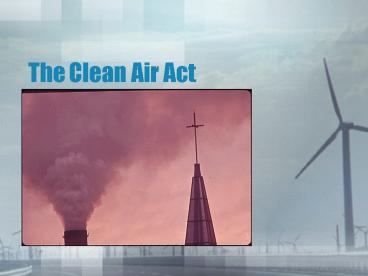The Clean Air Act PowerPoint PPT Presentation
1 / 25
Title: The Clean Air Act
1
The Clean Air Act
2
History of Clean Air Act
- Air Pollution Control Act of 1955
- Clean Air Act of 1963
- Clean Air Act of 1970
- Major revision
- Core provisions
- Amended again in 1977 and 1990
3
Statutory Goal of CAA
- to protect and enhance the quality of the
Nations air resources so as to promote the
public health and welfare and the productive
capacity of its population
4
Provisions
- National Ambient Air Quality Standard (NAAQS)
- From 1970 CWA
- law requires that EPA identify and set standards
for pollutants identified as harmful to human
health and the environment
5
National Ambient Air Quality Standard (NAAQS)
- Six criteria pollutants
- Carbon monoxide
- Nitrogen dioxide
- Ozone
- Sulfur dioxide
- Particulate matter with aerodynamic size less
than or equal to 10 micrometers (PM-10) - Lead
6
National Ambient Air Quality Standard (NAAQS)
- 2 Standards
- Primary standards
- Set limits to protect public health
- Secondary standards
- Set limits to protect against public welfare
effects, such as damage to farm crops and
vegetation, aesthetics, buildings, etc. - Must be met by 1975
7
National Ambient Air Quality Standard (NAAQS)
- Leaded gasoline phasedown
- By mid-1980s
- Was it successful?
8
State Implementation Plans (SIP)
- While EPA is responsible for setting NAAQS, the
states are responsible for establishing
procedures to meet the standards - State-level emission reduction strategies with
the goal of achieving the NAAQS by the legislated
date - What if a state fails to submit or implement an
adequate SIP? - Suspension of federal funding for major projects
like highway and transit projects
9
Emission Standards for Mobile Sources
- Cars and trucks
- 1990 amendments have significantly tightened
emission standards - Requires 77 to 95 emission reductions for
2004-2009 models - 97 reduction in the sulfur content of gasoline
beginning 2004
10
Emission Standards for Mobile Sources
- Clean-Fuel Fleet Program
- Alternative fuels
- Cleaner engines
- Low Emission Vehicle (LEV) standards
- For larger vehicles (10 or more passengers)
- Must purchase at least 30 clean-fuel vehicles
when they add new vehicles to existing fleets - 50 annually for heavy-duty fleets
11
Emission Standards for Mobile Sources
- Californias Zero Emission Vehicle (ZEV) program
- CAA grants CA the authority to develop its own
vehicle emission standards as long as those
standards meet the federal requirements - Stricter standards
12
Emission Standards for Mobile Sources
- Also set standards for diesel engines
- 90-95 reduction in emissions for 2000-2010 models
13
New Source Performance Standards (NSPS)
- Requires EPA to establish nationally-uniform,
technology-based standards for categories of new
industrial facilities - Consistent baseline for pollution control that
competing firms must meet - Preserve clean air to accommodate future growth
14
New Source Performance Standards (NSPS)
- Establish new emission standards for new major
stationary sources - Examples power plants, steel mills
- Best adequately demonstrated continuous control
technology available and taking cost into account
15
New Source Performance Standards (NSPS)
- Also applies to existing facilities through a
process called New Source Review (NSR) - Before, these older facilities were exempted
- But continued to pollute so NSR was adopted
16
Prevention of Significant Deterioration (PSD)
- Areas where air quality is better than that
required by NAAQS should be protected from
significant new air pollution even if NAAQS would
not be violated
17
Prevention of Significant Deterioration (PSD)
- 3 classes
- Class I National Parks, Wilderness areas,
Wildlife refuges, etc. - No decline allowed
- Class II All attainment and not classifiable
areas - Modest decline in air quality allowed
- Class III Selected areas that states may
designate for development - Large amount allowed but should be not exceed
NAAQS
18
Acid Deposition Control
- Added in 1990 amendment
- Reduction in SO2 emission
- 10 millions tons by 2000 from 1980 levels
- Reduction in NO2
- 2 million tons by 2000 from 1980 levels
19
Permits
- Requires states to administer a comprehensive
permit program for the operation of sources
emitting air pollutants - Annual fees are collected to cover reasonable
costs of administering the permit program - Revenues are to be used support air pollution
control program
20
Did CAA Work?
21
SO2 Emissions
22
NO2 Emissions
23
VOC Emissions
24
Particulate Matter Emissions
25
CO Emissions

